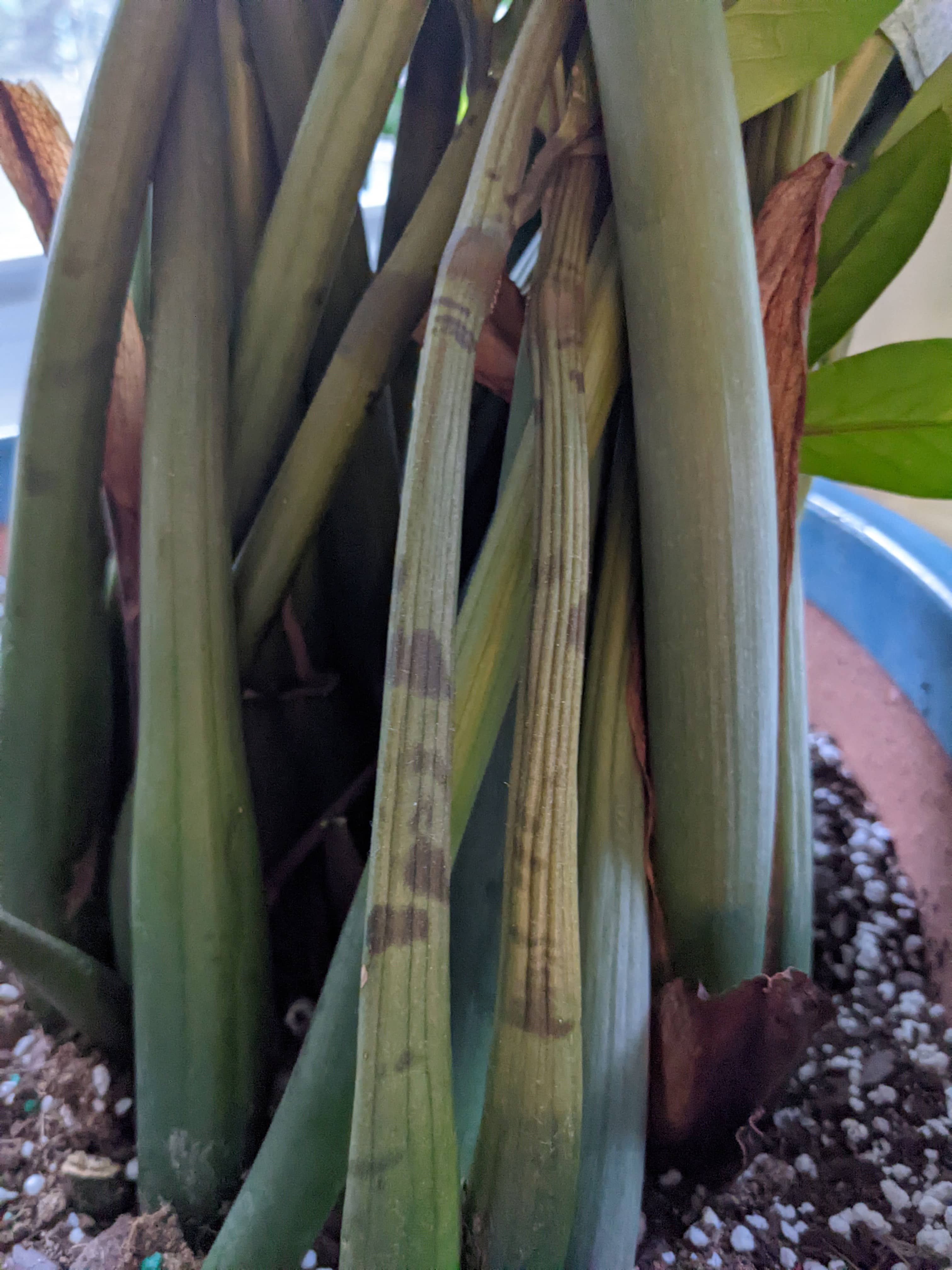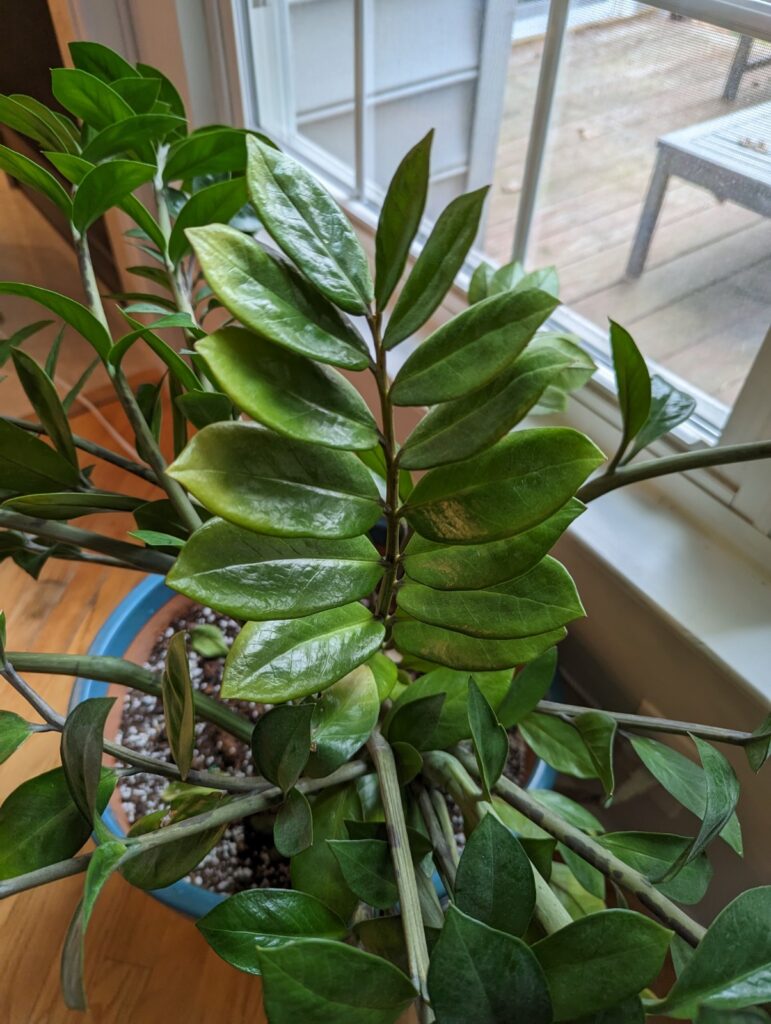How to Fix and Overwatered ZZ Plant
The ZZ Plant is a beloved houseplant that has remained popular for many years. They are often listed as “easy to care for” or “indestructible” because they will tolerate lower levels of light and they also don’t need to be watered very often. No doubt their popularity is also due to their beauty, ZZ Plants have plump stems and their leaves are shiny, thick, and dark green. The ZZ Plant has deceptively low water needs which can lead some plant owners to inadvertently overwater them.
Signs of an Overwatered ZZ Plant
An overwatered ZZ Plant might demonstrate an array of symptoms to let you know that it is receiving too much moisture. An overwatered ZZ Plant may exhibit wrinkled stems. Typically, ZZ Plants have plump stems. If a ZZ has been overwatered it may begin to die from the root, and the stems above the soil can become wrinkled in appearance. See the photo below for an example of what wrinkled stems.

Another sign that may indicate underwatering is yellow leaves or leaves with brown spots. ZZ Plants typically have darker green leaves. However, when they are first growing a new stem and leaves out of the soil, then the stem and leaves appear lighter green. Yellow or brown leaves aren’t normal. When leaves become yellow and brown, they are dying. Yellowing leaves can be a sign that you have overwatered your ZZ Plant. However, it can also mean that you have underwatered your ZZ Plant, which is quite confusing.
Your ZZ Plant does not have to have both wrinkled stems and yellowing leaves for it to be overwatered.
How to Detect and Fix Water Issues
My recommendation for detecting water issues (over- or underwatering) is to use a soil moisture meter. I use a simple soil moisture meter which has lasted me years and is probably my most used plant tool. These meters takes the guesswork out of moisture issues. Stick the probes in the soil and it lets you know how moist the soil is. The bonus is, you can use it for all your houseplants. Some people use their fingers to assess moisture. That seems too subjective to me, especially if you suspect you have a problem going on.
Overwatered ZZ Plant
Fixing an overwatered ZZ Plant can be difficult. It really depends on how overwatered it is. Success rates may vary greatly. You will first need to assess the damage by removing your ZZ Plant from its pot. Doing so will allow the roots, rhizomes, and soil to dry more quickly. When the root ball has dried enough to handle, inspect it for rot. Root rot happens when soil stays too wet for too long causing disease in the roots. Impacted roots will be brown and feel mushy. If you find root rot you must cut back the rotten pieces with a clean sharp knife. Allow the trimmed roots heal and callus over for a day or two, then you can repot your ZZ Plant in new soil and hope for the best. All of this will be very shocking to your plant, so be patient.
Underwatered ZZ Plant
As I mentioned some of the overwatering signs can also be underwatering signs as well. If you find that you have been underwatering, then you need to increase your watering in some manner. You might water your ZZ Plant more often, or you can give it a larger amount of water each time you water it. It's essential to find a balance because you don't want to overdo it and end up overwatering. Once you begin increasing watering, pay attention to whether the water runs quickly out of the bottom of the pot. If so, the soil may not be absorbing the water well enough. Soil that repels water is called hydrophobic and it can happen if soil gets too dry. If you notice this, you should water your ZZ Plant from the bottom to give the soil some time to absorb water.
After you have fixed your watering issues you still may have been left with yellow leaves on your ZZ Plant, unfortunately, these leaves will not regain their color. They will eventually fall off if you leave the on your ZZ Plant or you can pull them off if you want to. If you had wrinkled stems that were full of yellowing leaves, you may just want to prune the whole stem.
Other Problems to Look Out For
Fertilizing Issues
You probably came to this post because your ZZ Plant was exhibiting some signs of stress such as yellow leaves. Yellowing leaves can also be caused by nutrient issues. Fertilizer can be oversupplied and undersupplied. Typically, yellow leaves are more likely to be a sign of under-fertilization rather than over-fertilization. An overfertilized ZZ Plant is more likely to exhibit slow growth or even wilting. Common houseplant fertilizers have a balanced ratio of nitrogen, phosphorous, and potassium, or n-p-k, which you see on the labels of plant fertilizers. Yellow leaves may be a result of a lack of nitrogen or potassium. Nitrogen specifically helps promote healthy foliage growth.

After you ruled out water as an issue, then you may want to look into fertilization. Signs of a fertilization issue generally show up all over the plant rather than concentrated in one single area. Ask yourself when the last time you fertilized. If you have been fertilizing regularly, check your fertilizer’s instructions and make sure you've been following the directions for dosing and dilution correctly. In order to confirm a nutrient issue, I use soil rapitest to check the soil of my plants. It allows you to test for ph and each of the three main nutrients individually.
How to Fix Fertilization Issues
Overfertilized ZZ Plants need the soil to be flushed to wash out he excess nutrients. Do this by watering your ZZ Plant so that water runs out of the pot's drainage holes. Make sure your plant has the opportunity to dry out afterward, or you could end up overwatering.
An underfertilized ZZ Plant needs some fertilizer. Water-soluble, or liquid fertilizers, provide the quickest absorption. If you didn’t opt for the soil rapitest that I mentioned earlier, you should definitely use a balanced fertilizer that has the same (or similar) ratio of n-p-k. On the other hand if you know for sure you have a nitrogen deficiency, then you can find fertilizers that have a higher ratio of nitrogen compared to the other two nutrients. Same with the other two nutrients.
Pest Issues
Another issue that can cause yellowing leaves is pests. I personally recommend that you do a quick check of your plants for pests weekly. Catching pest infestations early is key in successfully getting rid of them. Pests that attack foliage and cause leaf yellowing are aphids, scale/mealybugs, spider mites, and thrips. The yellow from pest damage will look different from watering and fertilizing issues. Pest damage is spotty where the pests have fed on the leaves. I like using a flashlight to help look for pests, it can help you to better see contrast and webs. Pay a lot of attention to the underside of the leaves because pests camp there often.
How to Fix Pest Issues
Remove any infested plant away from other uninfested plants as soon as possible. Pest infestations spread rapidly. It will take a few weeks to completely eradicate pests. First, remove as many pests as you can see. A strong shower spray or a garden hose outside will remove most types of pests. Scale and mealybugs need to be removed manually because they have an armor-like shell. They scrape of easily though. Many people use rubbing alcohol on a Q-tip to kill and remove them.
After you have removed all the pests you can see, use an insecticide. You can use an organic version, like neem oil, or an inorganic one, like insecticidal soap. I have personally battled spider mites using neem oil successfully. Note that a single application of insecticide will never be enough. In fact, it’s best to repeat removal and insecticide application every few days until you have not seen a pests for over a week. This is essential because you have to battle pests through their whole lifecyle. Although you don't see them, their eggs may still remain on your plant.
Hopefully, this helps you determine if your ZZ Plant is overwatered or some other problem, and also puts you on your way to fix it. Have any questions? Post them in the Comments section below.
Add new comment